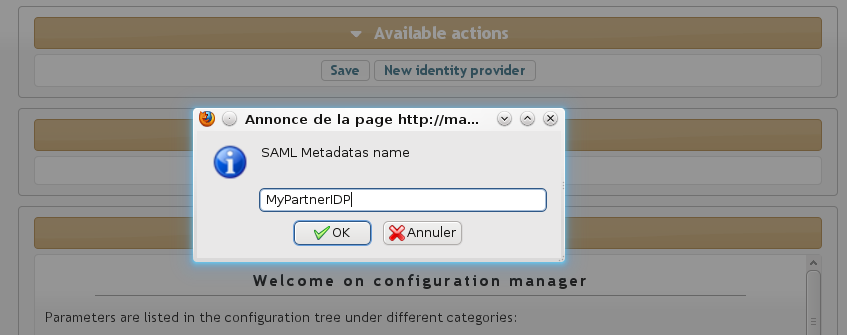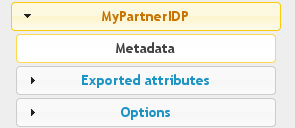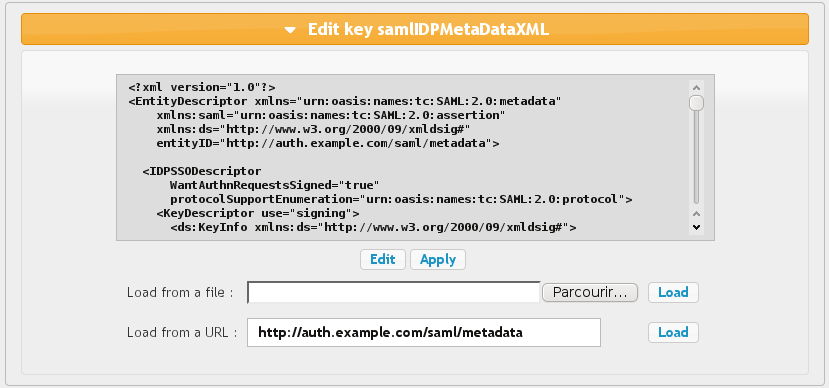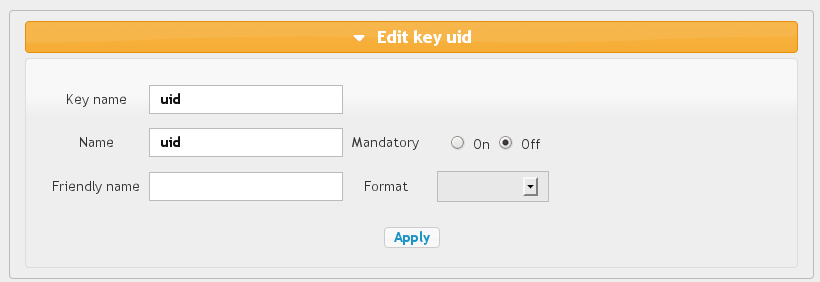SAML
| Authentication | Users | Password |
|---|---|---|
| ✔ | ✔ |
Presentation
LL::NG can use SAML2 to get user identity and grab some attributes defined in user profile on its Identity Provider (IDP). In this case, LL::NG acts like an SAML2 Service Provider (SP).
Several IDPs are allowed, in this case the user will choose the IDP he wants. You can preselect IDP with an IDP resolution rule.
For each IDP, you can configure attributes that are collected. Some can be mandatory, so if they are not returned by IDP, the session will not open.
Configuration
SAML Service
See SAML service configuration chapter.
Authentication and UserDB
In General Parameters > Authentication modules, set:
- Authentication module: SAML
- Users module: SAML
Register LemonLDAP::NG on partner Identity Provider
After configuring SAML Service, you can export metadata to your partner Identity Provider.
They are available at the EntityID URL, by default: http://auth.example.com/saml/metadata.
Register partner Identity Provider on LemonLDAP::NG
In the Manager, select node SAML identity providers and click on New identity provider:
The IDP name is asked, enter it and click OK.
Now you have access to the IDP parameters list:
Metadata
You must register IDP metadata here. You can do it either by uploading the file, or get it from IDP metadata URL (this require a network link between your server and the IDP):
Exported attributes
For each attribute, you can set:
- Key name: name of the key in LemonLDAP::NG session (for example “uid” will then be used as $uid in access rules)
- Mandatory: if set to On, then session will not open if this attribute is not given by IDP.
- Name: SAML attribute name.
- Friendly Name: optional, SAML attribute friendly name.
- Format (optional): SAML attribute format.
Options
General options
- Resolution Rule: rule that will be applied to preselect an IDP for a user. You have access to all environment variable, like user IP address.
For example, to preselect this IDP for users coming from 129.168.0.0/16 network:
$ENV{REMOTE_ADDR} =~ /^192\.168/
Authentication request
- NameID format: force NameID format here (email, persistent, transient, etc.). If no value, will use first NameID Format activated in metadata.
- Force authentication: set ForceAuthn flag in authentication request
- Passive authentication: set IsPassive flag in authentication request
- Allow proxied authentication: allow an authentication response to be issued from another IDP that the one we register (proxy IDP). If you disallow this, you should also disallow direct login form IDP, because proxy restriction is set in authentication requests.
- Allow login from IDP: allow a user to connect directly from an IDP link. In this case, authentication is not a response to an issued authentication request, and we have less control on conditions.
- Requested authentication context: this context is declared in authentication request. When receiving the request, the real authentication context will be mapped ton an internal authentication level (see how configure the mapping), that you can check to allow or deny session creation.
Session
- Adapt session lifetime: session lifetime will be adapted from
SessionNotOnOrAftervalue found in authentication response. It means that if the IDP propose to close session earlier than the default LemonLDAP::NG timeout, the session _utime will be modified so that session is erased at the date indicated by the IDP. - Force UTF-8: this will force UTF-8 conversion of attributes values collected from IDP.
Signature
These options override service signature options (see SAML service configuration).
- Sign SSO message: sign SSO message
- Check SSO message signature: check SSO message signature
- Sign SLO message: sign SLO message
- Check SLO message signature: check SLO message signature
Binding
- SSO binding: force binding to use for SSO (http-redirect, http-post, etc.)
- SLO binding: force binding to use for SLO (http-redirect, http-post, etc.)
Security
- Encryption mode: set the encryption mode for this IDP (None, NameID or Assertion).
- Check conditions: set to Off to disable conditions checking on authentication responses. Use with caution.



